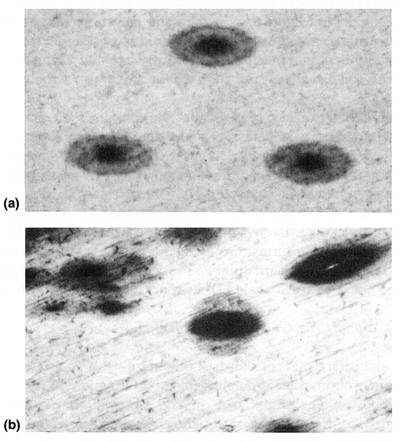| ESA | Return to https://www.halos.com/book/ctm-04-b.htm. | ESA |
[p. 54]
Secondary Polonium Halos: Another Discovery
My observations of the coalified wood specimens from the Colorado Plateau agreed with the major conclusions of other investigators. Evidence indicated that sometime in the past, prior to coalification, a uranium solution had infiltrated the wood when it was in a water-soaked, gel-like condition. As earlier noted, other investigators had reported the halos around uranium-rich centers. These I saw as well, often in abundance. This encouraged me to continue the search for secondary polonium halos in these specimens.
In this case persistence paid off—the long awaited day arrived. In a number of the coalified wood thin sections I discovered secondary polonium halos in greater numbers than the secondary uranium halos. Amazingly enough, sometimes there were over a hundred of them in just one square inch of a coalified wood thin section! Curiously, I found that the polonium halos in these specimens were of only one type—those that had formed from the accumulation of 210Po. None of the other two polonium halo types that occur in granites were seen. The reason for the absence of the 214Po and 218Po halos became clear after I reflected on the difference in the half-lives of the three isotopes.
In brief, the 210Po atoms lived long enough (half-life of 138 days) for them to be captured from the infiltrating uranium solution before they decayed away. In contrast, the other two polonium isotopes, with half-lives of minutes or less, decayed away before they could accumulate at the tiny polonium capture sites. Nature had provided the most favorable conditions for producing secondary polonium halos, namely, an abundant uranium supply coupled with high mobility. Yet even under these optimum conditions only one type of polonium halo had formed.
These experimental data presented an insurmountable obstacle to the idea of a secondary origin of polonium halos in granites. That is, if only one polonium halo type could form secondarily under the best natural conditions, what was the scientific basis for theorizing that all three types could form secondarily in the granites? In these rocks both the high uranium content and rapid transport capability were missing.
And this was not all. Most of the secondary 210Po halos in coalified wood exhibited elliptical rather than the circular cross-sections typical of halos in minerals. How were these unusual halos produced? The simplest reconstruction of events pictures uranium solutions infiltrating water-soaked wood that was freshly emplaced in the Colorado Plateau deposits. Halo radiocenters, composed of lead and selenium, accumulated atoms of 210Po out of that [p. 55] solution. In less than a year, secondary 210Po halos developed from the alpha decay of those atoms. Naturally, these halos first formed as spheres and hence initially had a circular outline, just as the halos in minerals. However, as pressure from overlying sediments increased, the gel-like wood was easily compressed, thus leading to the development of the elliptical halos as shown in Figure 4.1(a) and the Radiohalo Catalogue. Their occurrence in three geological formations suggests they all originated at about the same time in agreement with the flood-related scenario.
 Figure 4.1 Polonium Halos in Coalified Wood (a) shows elliptical 210Po halos in coalified wood typical of those occurring in the Triassic, Jurassic, and Eocene formations in the Colorado Plateau, and (b) shows the dual 210Po halo (magnification × 250) |
It could be argued, however, that secondary polonium halos might have formed in three widely spaced but almost identical geological scenarios instead of the one scenario related to the flood. To be fair, we must carefully examine this possibility.
[p. 56]
Here we must realize that the formation of secondary polonium halos required an extraordinarily complex, interrelated series of geological events. The basic ingredients were: (1) water, (2) uprooted trees as the source of the logs and smaller wood fragments, (3) a rich uranium concentration near the wood, and (4) a compression event occurring after the uranium solution invaded the wood, but prior to its becoming coalified. The gel-like condition of the wood suggests only a short time had elapsed since the trees had been uprooted. At the very time the wood was in this special condition, it had to be infiltrated by a solution that had recently dissolved uranium from a nearby deposit. Note that, if the water had contacted the uranium deposit after infiltrating the wood, there would have been no radioactivity in solution and hence no possibility of forming secondary halos. The same is true if the wood had already turned to coal before contact with the uranium solutions.
The evolutionary scenario requires that the complex sequence of events described above must have been repeated more than ten million years later in the same geographical location. That this scenario would occur a third time, again in the same area about fifty million years later, seems improbable. Yet the issue must not be decided merely on the basis of improbability. Instead, we must determine whether this interpretation is in harmony with all the scientific data. Previously, geologists drew conclusions about the history of the Colorado Plateau formations based on data then available to them. We must now focus special attention on the new data presented by the halos in coalified wood to see if these earlier conclusions are still justified.

|
© 2004
Earth Science Associates